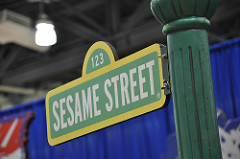 Sesame Street, a show you loved when you were a kid, and one that your kids enjoy today, has launched a major autism initiative. The program is called “See Amazing in All Children”. It is designed to foster greater understanding about autism for all children and families.
Sesame Street, a show you loved when you were a kid, and one that your kids enjoy today, has launched a major autism initiative. The program is called “See Amazing in All Children”. It is designed to foster greater understanding about autism for all children and families.
There is a stigma placed upon autism that need not be there. People who do not understand autism, or who do not have anyone in their lives that has it, may harbor many misconceptions about it. The goal of the Sesame Street autism initiative is to help de-stigmatize autism (which affects one in 68 American children).
To do this, they have introduced a new Sesame friend named Julia. She is a preschool girl with autism who does things a little differently than her friends Elmo, Abby Cadabby, and Grover. Julia is the first muppet with autism.
The See Amazing Guide can be accessed for free by parents. It includes a digital story book called We’re Amazing, 1, 2, 3! which features Julia, Abby, and Elmo. Julia and Elmo are having a playdate. Elmo points out that he and Julia like to play with the same things, but they play with those toys in different ways.
Later, Elmo introduces his friend Abby to Julia. Elmo teaches Abby to wait after asking Julia a question so that Julia has time to answer. He informs Abby that Julia has autism, so she does things a little differently. He points out that sometimes, he has to talk with Julia using fewer words or by saying the same thing a few times. The book includes a scene where Abby is “stimming” by flapping her arms, and another scene where she becomes overwhelmed by a blender noise in a store.
The best thing about this storybook is that it explains autism from a child’s point of view. It also shows children who do not have autism how to be a good friend to a child who does have it. For example, it points out that if another kid isn’t making eye contact with you, that doesn’t automatically mean that he or she doesn’t like you.
The guide also includes a “Read More” section where parents can learn more. One section is about taking care of the caretaker. Another is about how to prepare for outings. There is a section that guides parents about what to say to a parent of a child who has autism.
Parents can access free Daily Routine Cards from the guide. These are to be used to help a child who has autism learn the different steps that are involved in everyday activities (such as teeth-brushing). These are just a few of the things that are available in the See Amazing Guide.
Image by USAG-Humphreys on Flickr.
Related Articles at Families.com:
* Teenager With Autism Wants to Become Miss America
* Studies Show Chelation Doesn’t Help Autism
* Brain Wiring: Understanding the Autistic Mind

